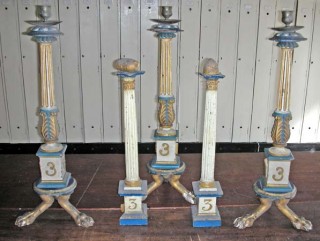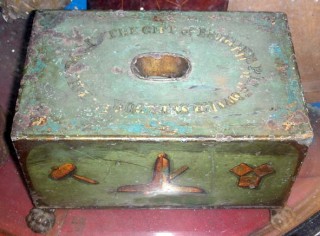The Third Lodge of Ireland
Constituted 1808
Meets at 27, Tuckey Street, Cork
Third Monday of every month, at 8.00 pm
(excluding June, July, and August)
Lodge Contact: secretary@thirdlodge.ie
 There is no record in register of Grand Lodge as to the date of grant of the original No. 3 warrant, but it was probably in existence on 1 February 1732. In 1735, it was meeting in the Bull’s Head Tavern in Ormond Market (Smith, 1735), and by 1744 had changed to Lebeck’s Head Tavern in Dame Street. This number was erased, 5 November 1801. The first sign of a revival of the No. 3 warrant comes in a letter from Grand Master The Rt Hon. The Earl of Donoughmore, dated 12 April 1808 and addressed to the Provincial Grand Master of Munster, Doctor Westropp, mentioning the recently revived No. 3 lodge, which he had ‘much pleasure in reviving in the respecable name of Captain John Travers as Master and complying thereby with the wishes so strongly expressed by our worthy Brother Sir Richard Kellett.’ From this letter, it may be deduced that a meeting of the Province had resolved that the warrant be revived; further, that a letter requesting the Grand Master to so revive was delivered and acted upon, it would appear, on 6 April 1808. At a meeting of The Grand Lodge of Ireland the following day This lodge warrant was issued to the City of Cork on 4 July 1808, under the title ‘Third Lodge of Ireland’.
There is no record in register of Grand Lodge as to the date of grant of the original No. 3 warrant, but it was probably in existence on 1 February 1732. In 1735, it was meeting in the Bull’s Head Tavern in Ormond Market (Smith, 1735), and by 1744 had changed to Lebeck’s Head Tavern in Dame Street. This number was erased, 5 November 1801. The first sign of a revival of the No. 3 warrant comes in a letter from Grand Master The Rt Hon. The Earl of Donoughmore, dated 12 April 1808 and addressed to the Provincial Grand Master of Munster, Doctor Westropp, mentioning the recently revived No. 3 lodge, which he had ‘much pleasure in reviving in the respecable name of Captain John Travers as Master and complying thereby with the wishes so strongly expressed by our worthy Brother Sir Richard Kellett.’ From this letter, it may be deduced that a meeting of the Province had resolved that the warrant be revived; further, that a letter requesting the Grand Master to so revive was delivered and acted upon, it would appear, on 6 April 1808. At a meeting of The Grand Lodge of Ireland the following day This lodge warrant was issued to the City of Cork on 4 July 1808, under the title ‘Third Lodge of Ireland’.
The registry of the Third Lodge of Ireland records that ‘the original warrant of this Lodge, dated 1725, and the records were taken away by a Brother who was unfortunately obliged to leave the Country in the year 1807’. It continues by quoting the Provincial Grand Lodge of Munster minutes of 31 May 1808, when with ‘Thomas Westropp M.D., Provincial Grand Master in the chair, the Worshipful Master was pleased to install John Travers Esquire Master of Lodge No. 3, Richard Bagley and George Noblett Esquires Senior and Junior Wardens of the same and they are hereby authorised and appointed to hold the Lodge of No. 3 in the City of Cork.’ Interestingly, Lodge No. 3 did not hold its first regular meeting ‘from causes not worth mentioning’ for another two years, until 30 May 1810, at which meeting it was agreed that meetings ‘be resumed and continued and a punctual attendance observed’, while also resolving to ‘prepare a body of Bye-Laws for the inspection and approbation of the entire Lodge.’ A connection with maritime professions can be readly seen among Third Lodge members from an early date. On 26 October 1810 brothers Abraham and Joshua Har[d]grave were initiated into the Lodge. Both brothers were to become architects, as had their father, all of whom have left many examples of their considerable talents around County Cork in particular. Brother Abraham Hargrave became a member of the Royal Cork Yacht Club in 1828 and acquired both a yacht called Giaour and a colourful reputation for the manner in which he sailed her. According to Hargrave family tradition, in the 1850s, the Giaour was sailed to Australia by Abraham’s sons; if true, thouse was an epic voyage.
By 1816, according to the surviving extracts of the earliest surviving minutes, the lodge was then meeting at the Crown Tavern, in the South Gate Bridge area of the city, where it remained for many years. In the early decades, military personal and merchant seamen featured prominently among the membership. In these cases – given the likelihood of their removal from Cork – the usual form seems to have been to propose, ballot for and – if approved – to give both First and Second degrees to the candidate, all on the same night. We are fortunate to have an original copy of the 19 June 1819 issue of The Southern Reporter and Cork Commercial Courier newspaper, mounted on display in The Supper Room, where an installation meeting of Third Lodge on 24 June 1819 was advertised. In this period, lodge officers changed every six months, being installed on St John’s Day. Apparently there was always an election with three candidates for Worshipful Master; likewise where were three candidates for the post of Warden, the winner being appointed Senior and the runner-up, Junior.
 By 1822, lodge was meeting at the Chamber of Commerce Hotel. About this time, lodge invested in upgrading its regalia, including new collar jewels, some of which have survived in use to the present day. There are a number of gaps in our records, covering the period 1822/3 to 1858/9. However, it is possible to discern certain things from our membership records. One member, Lieutenant Bro. Richard Roberts from Passage West, following a career in the Royal Navy, was later to command the Sirius, the first ship to cross the Atlantic entirely under steam power. She left Cork harbour on 4 April 1838 and reached New York eighteen days later. Another member, Frederick J. Honan, initiated in 1842, was a member of the prominant Cork mercantile dynasty of that name, after whom the Honan Chapel at University College Cork is named.
By 1822, lodge was meeting at the Chamber of Commerce Hotel. About this time, lodge invested in upgrading its regalia, including new collar jewels, some of which have survived in use to the present day. There are a number of gaps in our records, covering the period 1822/3 to 1858/9. However, it is possible to discern certain things from our membership records. One member, Lieutenant Bro. Richard Roberts from Passage West, following a career in the Royal Navy, was later to command the Sirius, the first ship to cross the Atlantic entirely under steam power. She left Cork harbour on 4 April 1838 and reached New York eighteen days later. Another member, Frederick J. Honan, initiated in 1842, was a member of the prominant Cork mercantile dynasty of that name, after whom the Honan Chapel at University College Cork is named.
In 1864, Third Lodge came into the possession of an eighteenth century Masonic chair (currently used by the Junior Warden and reputedly used on the night The Lady Freemason, The Hon. Elizabeth St Leger of Doneraile was initiated. Lodge brought this chair with them to their meeting place at Maylor Street where, in common with a number of city lodges, they rented from the 1860s until the 1920s. In 1908, Third Lodge celebrated its centenary of the granting of our warrant with the casting of a special commemorative medal or jewel (an act repeated in 2008 for our bicentennary). And thus our proud tradition continues to this day.
History of Warrant No. 3
There is no record in register of Grand Lodge as to the date of grant of the original No. 3 warrant, but it was probably in existence on 1 February 1732. In 1735, it was meeting in the Bull’s Head Tavern in Ormond Market (Smith, 1735), and by 1744 had changed to Lebeck’s Head Tavern in Dame Street. This number was erased, 5 November 1801.
A new warrant was issued 4 July 1808 to CORK under the title ‘Third Lodge of Ireland’, where it has worked since.
